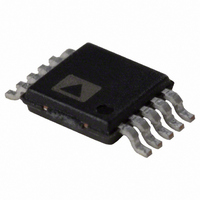AD5664RBRMZ-3 Analog Devices Inc, AD5664RBRMZ-3 Datasheet - Page 13

AD5664RBRMZ-3
Manufacturer Part Number
AD5664RBRMZ-3
Description
IC DAC NANO 16BIT 1.25V 10-MSOP
Manufacturer
Analog Devices Inc
Series
nanoDAC™r
Specifications of AD5664RBRMZ-3
Data Interface
Serial
Settling Time
4µs
Number Of Bits
16
Number Of Converters
4
Voltage Supply Source
Single Supply
Power Dissipation (max)
6.6mW
Operating Temperature
-40°C ~ 105°C
Mounting Type
Surface Mount
Package / Case
10-MSOP, Micro10™, 10-uMAX, 10-uSOP
Resolution (bits)
16bit
Sampling Rate
220kSPS
Input Channel Type
Serial
Supply Current
950µA
Digital Ic Case Style
SOP
No. Of Pins
10
Lead Free Status / RoHS Status
Lead free / RoHS Compliant
For Use With
EVAL-AD5664REBZ - BOARD EVALUATION FOR AD5664R
Lead Free Status / RoHS Status
Lead free / RoHS Compliant, Lead free / RoHS Compliant
Available stocks
Company
Part Number
Manufacturer
Quantity
Price
Part Number:
AD5664RBRMZ-3
Manufacturer:
ADI/亚德诺
Quantity:
20 000
TERMINOLOGY
Relative Accuracy or Integral Nonlinearity (INL)
For the DAC, relative accuracy or integral nonlinearity is a
measurement of the maximum deviation, in LSBs, from a
straight line passing through the endpoints of the DAC transfer
function. A typical INL vs. code plot can be seen in Figure 4
and Figure 5.
Differential Nonlinearity (DNL)
Differential nonlinearity is the difference between the measured
change and the ideal 1 LSB change between any two adjacent
codes. A specified differential nonlinearity of ±1 LSB maximum
ensures monotonicity. This DAC is guaranteed monotonic by
design. A typical DNL vs. code plot can be seen in Figure 6 and
Figure 7.
Zero-Scale Error
Zero-scale error is a measurement of the output error when
zero code (0x0000) is loaded to the DAC register. Ideally, the
output should be 0 V. The zero-code error is always positive in
the AD5624/AD5664 because the output of the DAC cannot go
below 0 V. It is due to a combination of the offset errors in the
DAC and the output amplifier. Zero-code error is expressed in
mV. A plot of zero-code error vs. temperature can be seen in
Figure 12.
Full-Scale Error
Full-scale error is a measurement of the output error when full-
scale code (0xFFFF) is loaded to the DAC register. Ideally, the
output should be V
of FSR. A plot of full-scale error vs. temperature can be seen in
Figure 11.
Gain Error
This is a measure of the span error of the DAC. It is the
deviation in slope of the DAC transfer characteristic from ideal
expressed as a % of FSR.
Zero-Code Error Drift
This is a measurement of the change in zero-code error with a
change in temperature. It is expressed in μV/°C.
Gain Temperature Coefficient
This is a measurement of the change in gain error with changes
in temperature. It is expressed in ppm of FSR/°C.
Offset Error
Offset error is a measure of the difference between V
and V
transfer function. Offset error is measured on the AD5624/
AD5664 with code 512 loaded in the DAC register. It can be
negative or positive.
OUT
(ideal) expressed in mV in the linear region of the
DD
− 1 LSB. Full-scale error is expressed in %
OUT
(actual)
Rev. 0 | Page 13 of 24
DC Power Supply Rejection Ratio (PSRR)
This indicates how the output of the DAC is affected by changes
in the supply voltage. PSRR is the ratio of the change in V
a change in V
in dB. V
Output Voltage Settling Time
This is the amount of time it takes for the output of a DAC to
settle to a specified level for a ¼ to ¾ full-scale input change
and is measured from the 24
Digital-to-Analog Glitch Impulse
Digital-to-analog glitch impulse is the impulse injected into the
analog output when the input code in the DAC register changes
state. It is normally specified as the area of the glitch in nV-s,
and is measured when the digital input code is changed by
1 LSB at the major carry transition (0x7FFF to 0x8000) as
shown in Figure 22.
Digital Feedthrough
Digital feedthrough is a measure of the impulse injected into
the analog output of the DAC from the digital inputs of the
DAC, but is measured when the DAC output is not updated. It
is specified in nV-s, and measured with a full-scale code change
on the data bus, that is, from all 0s to all 1s and vice versa.
Total Harmonic Distortion (THD)
This is the difference between an ideal sine wave and its
attenuated version using the DAC. The sine wave is used as the
reference for the DAC, and the THD is a measurement of the
harmonics present on the DAC output. It is measured in dB.
Noise Spectral Density
This is a measurement of the internally generated random
noise. Random noise is characterized as a spectral density
(nV/√Hz). It is measured by loading the DAC to midscale and
measuring noise at the output. It is measured in nV/√Hz. A plot
of noise spectral density can be seen in Figure 27.
DC Crosstalk
DC crosstalk is the dc change in the output level of one DAC in
response to a change in the output of another DAC. It is
measured with a full-scale output change on one DAC (or soft
power-down and power-up) while monitoring another DAC kept
at midscale. It is expressed in μV.
DC crosstalk due to load current change is a measure of the
impact that a change in load current on one DAC has to
another DAC kept at midscale. It is expressed in μV/mA.
REF
is held at 2 V, and V
DD
for full-scale output of the DAC. It is measured
th
falling edge of SCLK.
DD
is varied by ±10%.
AD5624/AD5664
OUT
to













